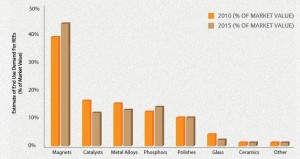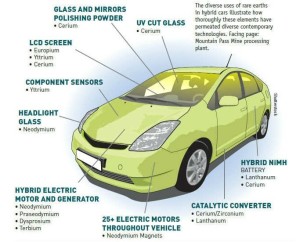AUTHOR: Muhammad Awais
Dear Reader,
A question which might have crossed your mind is what are Rare Earths? Another question might be why are they called rare earth elements and what are their real life applications? To answer these questions, we start with what are rare earth elements (REEs).
The rare-earth elements (REEs) are a group of 17 elements (atomic numbers 57-71) that exhibit a range of unique electronic, optical and magnetic properties. Because of their similarities to the REEs, scandium (Sc) and yttrium (Y) are considered by most scientists to be REEs too [1].
A common assumption made by many people is that there must be a small number of these elements on the planet. They are, in fact, quite abundant but just difficult to separate which makes heir presence on earth rare. Some rare earths are in fact more abundant than other better known elements. For example, there is more of the rare earth element neodymium than there is of gold. There are, however, many economic deposits of gold, but very few of neodymium. The term “rare earth” comes from their initial discovery in which only tiny portions of these minerals could be isolated from larger quantities of still more common elements. Another mistake is to believe that these elements are created from common earth, when in fact they are classified as metals.
How are Rare Earths used?
The global demand for rare earths has increased as more uses for these elements are found. Here are a few examples of how rare earth elements are being utilized in the world today [2].
Another mistake is to believe that these elements are created from common earth, when in fact they are classified as metals.
- Key applications:
2. Uses of Rare Earths:
3. REE composition by end use:
4. Automotive applications:
High Demand for Rare Earths:
In the last 20 years the importance of rare earth elements has increased drastically due to three main factors:
- High demand: An increasing global demand for new products and emerging technologies that contain rare earth elements (REE).
- Uncertain supply: China, the world’s largest source of rare earth materials at the present time, combats smuggling and also closes some of its major mines. Currently, China provides over 90 percent of the world’s total output of rare earths.
- No substitutions: The unique electronic, optical and magnetic characteristics of these elements cannot be matched by any other metals or synthetic substitutes.
Combined, these three factors have raised a growing level of concern that other rare earth mining sites need to be found outside of China, explored and brought online in short order [2].

Figure 6: Demand of comparison of REEs (Source: Technology metals research LLC Feb 2011) (TMR Report)
Forecasted Shortages:
The U.S. Department of Energy is anticipating a critical shortage of 5 rare earth elements necessary for green technology development and construction. These REE are neodymium, europium, terbium, dysprosium and yttrium [3].
Already it’s believed that the United States and several other countries are beginning to stockpile their reserves of REE in anticipation of these anticipated shortages.

Figure 7: Criticality matrix of selected important metals (Source: US Department of Energy, Technology Metal Research)
Why REEs are considered more valuable?
The prices vary widely with heavy rare earths historically commanding significantly higher prices than light rare earths. Several of these elements can reach extremely high prices depending on their scarcity and commercial applications. Europium, terbium and dysprosium have been recently priced in the range of $500 – $900/kg. While prices have dropped 70-95% from 2011 peaks, prices are still up over 130% from 2010 prices and heavies have maintained their value relative to lights. Lanthanum and cerium are nearing historic price levels.
Less expensive rare earths like lanthanum and cerium (although the prices of which are nearing historic price levels) are used extensively in modern technology, such as in the manufacturing of catalytic converters that automobiles require.
Many of the high tech devices enjoyed by the western world need rare earths to work. Consumer smartphones, TVs, batteries, computers, and medical equipment, even some of the critical components in nuclear reactors depend on rare earth elements for their operation.
This widespread need for REE in global manufacturing ensures a constant commercial desire for these metals for the foreseeable future.
References
| [1] | [Online]. Available: www.namibiarareearths.com/rare-earths.asp. |
| [2] | [Online]. Available: http://metalpedia.asianmetal.com/metal/rare_earth/application.shtml. |
| [3] | U. D. O. ENERGY, “CRITICAL MATERIALS STRATEGY,” December 2011. |

 European Training Network for the Design and Recycling of Rare-Earth Permanent Magnet Motors and Generators in Hybrid and Full Electric Vehicles (DEMETER)
European Training Network for the Design and Recycling of Rare-Earth Permanent Magnet Motors and Generators in Hybrid and Full Electric Vehicles (DEMETER)








